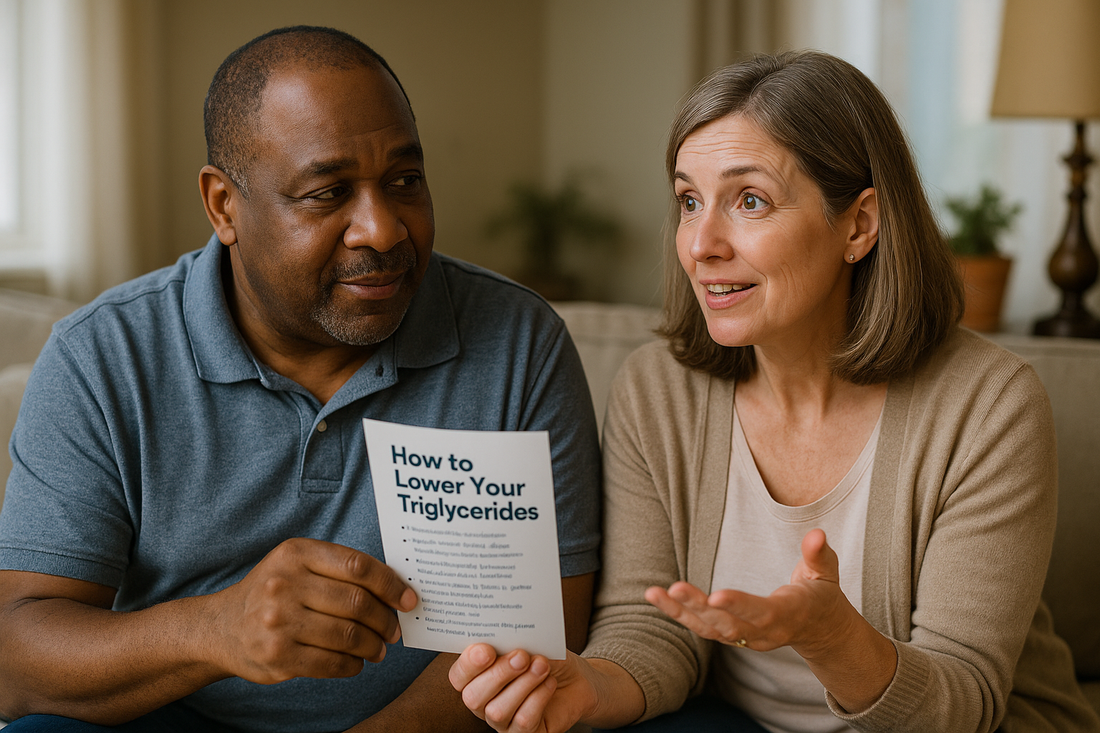
How to Help Someone Lower Their Triglycerides — and Get Them to Actually Take Action
Share
What Are Triglycerides?
Triglycerides are a type of fat in your blood. After you eat, your body converts extra calories into triglycerides and stores them in fat cells. Later, hormones release them for energy.
That’s normal. But if your triglyceride levels stay high for too long, it can lead to serious health problems.
Why high triglycerides matter:
-
Heart disease & stroke risk: High triglycerides often travel with other cardiovascular risk factors like high LDL cholesterol and low HDL cholesterol .
-
Pancreatitis: Levels over 500 mg/dL can trigger dangerous inflammation in the pancreas .
-
Metabolic syndrome: High triglycerides are one piece of this cluster of conditions that also includes high blood pressure, high blood sugar, and excess belly fat .
A healthy triglyceride level is below 150 mg/dL according to the American Heart Association.
Why This Guide Matters
Most people have heard high triglycerides are bad — but they don’t know exactly what to do about them.
Even more important: giving someone facts isn’t enough. If you want to help, you also need to know how to explain those facts in a way that makes them want to act.
This guide gives you both:
-
Evidence-based steps to lower triglycerides.
-
Communication strategies that make advice stick.
Step 1: Know What Raises Triglycerides
Before suggesting changes, you have to know the common causes:
-
Eating too many calories (especially from sugary foods and drinks) .
-
Diets high in refined carbohydrates.
-
Excess alcohol intake .
-
Being overweight, especially with abdominal fat .
-
Lack of physical activity .
-
Certain health conditions (like uncontrolled diabetes or kidney disease).
-
Some medications (steroids, beta blockers, birth control pills).
Step 2: Actions That Lower Triglycerides — And Why They Work
Here’s what science says works:
1. Cut Back on Added Sugars
Why it works:
Added sugar raises blood sugar and insulin, which signals your body to store fat as triglycerides. Studies show cutting added sugars can lower triglycerides by up to 25% .
Easy swaps:
-
Replace soda with sparkling water and lemon.
-
Choose fruit instead of dessert.
-
Check labels — ketchup, bread, and sauces can hide sugar.
2. Reduce Refined Carbs
Why it works:
White bread, pasta, and pastries spike blood sugar just like sugar does. Replacing them with whole grains reduces triglyceride production .
3. Eat More Omega-3 Fatty Acids
Why it works:
Omega-3s from fish like salmon and sardines help your body process fat better and reduce triglycerides .
What to do:
-
Eat fatty fish twice a week.
-
Add chia or flax to smoothies.
4. Move Your Body Daily
Why it works:
Exercise increases the enzymes that help clear triglycerides from your blood . Even brisk walking can help.
5. Maintain a Healthy Weight
Why it works:
Losing just 5–10% of your weight can lower triglycerides by as much as 20% .
6. Limit Alcohol
Why it works:
Alcohol turns into sugar in the body and is strongly linked to high triglycerides .
7. Don’t Overeat
Why it works:
Extra calories get stored as triglycerides, even from “healthy” foods if you eat too much.
Step 3: How to Talk So People Listen
You can know all the science, but if you say it wrong, they’ll tune out.
-
Start with their goals: Tie the advice to something they care about.
-
Use “we” instead of “you”: Makes it feel like teamwork.
-
Share success stories: Real examples make it feel possible.
-
Offer to do it with them: Removes the fear of starting alone.
-
Give one or two steps at a time: Avoid overwhelm.
-
Highlight quick wins: More energy, better sleep, less bloating.
Step 4: Create a Support Plan
-
Plan healthy meals together.
-
Set reminders for walks.
-
Celebrate progress.
Step 5: When to Get Professional Help
If lifestyle changes don’t help in a few months, encourage:
-
Regular testing (home kits or doctor visits).
-
Medical evaluation for underlying causes.
Step 6: Keep It Going
-
Check in weekly.
-
Try new recipes.
-
Make activity part of life, not just “exercise time.”
Key Takeaways
-
High triglycerides are common but can be lowered.
-
Small, consistent changes work.
-
Communication style can make or break success.
- Explore regular testing
References
-
Miller M et al. “Triglycerides and cardiovascular disease: a scientific statement from the American Heart Association.” Circulation, 2011.
-
Scherer J et al. “Causes and management of hypertriglyceridemia-induced acute pancreatitis.” Gastroenterology Research and Practice, 2014.
-
Grundy SM. “Metabolic syndrome pandemic.” Arteriosclerosis, Thrombosis, and Vascular Biology, 2008.
-
Parks EJ, Hellerstein MK. “Carbohydrate-induced hypertriacylglycerolemia.” American Journal of Clinical Nutrition, 2000.
-
Chait A, Brunzell JD. “Alcohol and triglycerides.” American Journal of Clinical Nutrition, 1983.
-
Després JP. “Abdominal obesity and cardiovascular disease.” Nature, 2012.
-
Leon AS, Sanchez OA. “Response of blood lipids to exercise training.” Sports Medicine, 2001.
-
Johnson RK et al. “Dietary sugars intake and cardiovascular health.” Circulation, 2009.
-
Volek JS et al. “Carbohydrate restriction has a more favorable impact on the metabolic syndrome than a low fat diet.” Lipids, 2009.
-
Balk EM et al. “Effects of omega-3 fatty acids on serum markers of cardiovascular disease risk.” Atherosclerosis, 2006.
-
Thompson PD et al. “Exercise and physical activity in the prevention and treatment of atherosclerotic cardiovascular disease.” Circulation, 2003.
-
Dattilo AM, Kris-Etherton PM. “Effects of weight reduction on blood lipids and lipoproteins: a meta-analysis.” American Journal of Clinical Nutrition, 1992.
-
Klop B et al. “Alcohol and plasma triglycerides.” Current Opinion in Lipidology, 2013.
